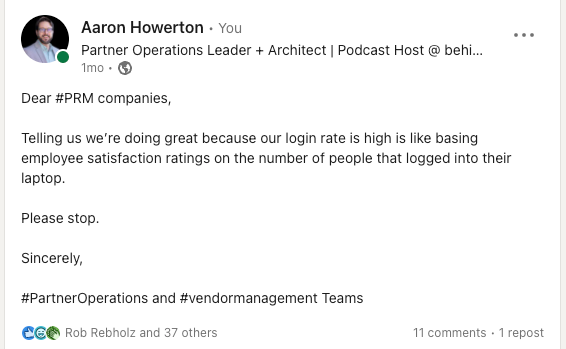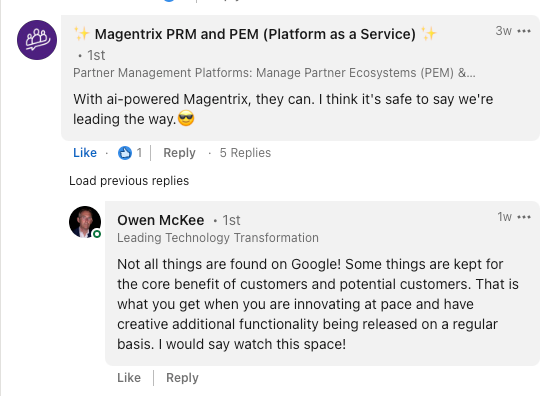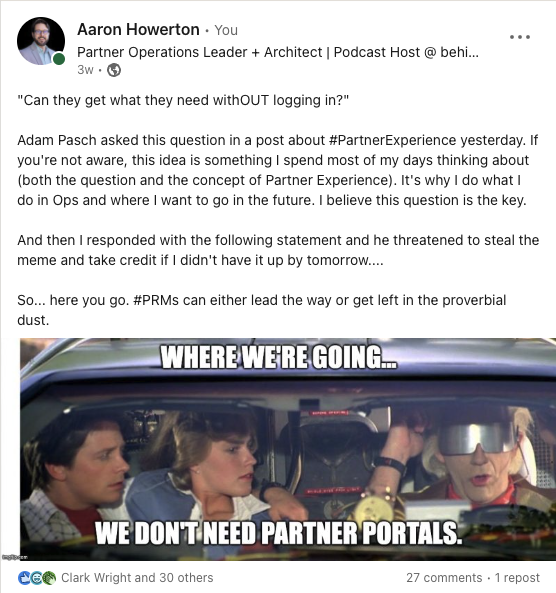... and it’s not even well-defined yet.
In October of 2022, I was laid off for the first time in my professional career. It was a bit surreal, but it led to a lot of interesting conversations and opportunities.
Changing jobs is almost a past-time for many of us working in software. It’s how we level up. We invest 1-4 years, take on some interesting projects, and then have to leave to get promotions, new challenges, better pay, and occasionally a moonshot on an early stage run at big wins via IPO or acquisition.
The process has taught me a lot about how to network effectively, find new opportunities, and research a company in preparation for conversations. Invariably, I get frustrated at a single point.
Searching the company across multiple websites to glean insights and prepare for calls.
First, there’s the company domain.
Review the site, and learn what you can with a particular focus on the job description. Glean truth through the marketing BS about their values, watch out for buzzwords like ’family’ and ’superstars’, and see what you can see.
Then there is a myriad of sites for more details.
- Company reviews and details on sites like Glassdoor, Comparably, LinkedIn Insights, and The Org.
- Product reviews on G2, Capterra, Trust Radius, and Gartner.
- Funding details over at Crunchbase.
As you can imagine, that’s a lot of searching, and there’s definitely more.
It absolutely drove me nuts. It still does because company research has a lot of applications.
I keep asking myself one question: why does this have to be so challenging?
Building a solution
Months had gone by with this idea in the back of my mind. Getting others engaged was hard because my budget is basically zero, and it seems people often like to be paid for their work (psh.. yeah... right.... ). The idea is simple: take a company and get the links for me to relevant sites. Save me a bit of effort.
Enter ChatGPT.
Three weeks ago, on March 23, to be precise, I sat down with a beer at a local coffee shop (yes... fresh draft beer at a coffee shop...) and a couple of hours of uninterrupted effort with ChatGPT to see what I could do about solving my problem. Two hours later — with no more than a few limited historical attempts to edit breaks and headers in HTML — I had a base script returning results.
It only cost me a $3 happy-hour local draft beer and two hours of focused effort.
Today, after a variety of iterations and some great feedback from willing test subjects, I have OSCARTech. OSCAR isn’t perfect yet, of course. He’s a bit cantankerous with results, depending on the company branding and domain, but he’s generally useful and doesn’t seem to mind pitching it. He also only exists because of AI.
When you go check it out, it’ll feel like a neat trick, and maybe you’ll bookmark the site to try again later when you ’need it.’ I think that would, as my son might say, freaking amazing. Go ahead and check it out...I can wait.
Connecting the dots
So what does this have to do with Partner Experience?
Bear with me. We’ll get there. For now, just realize....
AI enabled me to build an MVP solution without any of the technical background that would commonly slow me down.
ChatGPT helped me take an idea from ideation to delivery in three weeks for roughly $3 in monthly operating cost (Domain + Website Builder). I’m not even on the Pro account (but I probably will be soon).
AI is everywhere right now. No effort to slow it down will stop it. The impact it will have on "white collar" professionals will vastly exceed even the introduction of the PC to the business setting. It’s a disruption unlike anything we’ve ever seen for working professionals... and at the same time, it’s part of the repeating cycle of disruption we’ve come to appreciate in the software industry.
Partner Tech is far from excluded from this disruption.
In fact, it’s ripe for innovation as more and more platforms fight for competitive advantages to solve the ever-present problem of "How do we collaborate with Partners in efficient, effective ways?"
PRM is a hot topic
This month I’ll get to participate in not one, but two different panels on Partnerships and PRM technology. I’m giddy. There are some really fantastic people participating and some really interesting technology on the table.
Industry leaders are talking about PRM more than ever in my feed (which is, admittedly, a bit of an echo chamber for Partnerships and Partner Tech right now). The number of players in the market for this space is also growing because legacy platforms are struggling to keep up with the demand for new partner models, specifically those around Tech and Alliance Partnerships.
There’s a whole history here that’s really fascinating and is likely answered by people with more experience than me. Suffice it to say the general theme of comments is that engagement and utilization hasn’t improved much since their original inception.
I made this post a few weeks ago...

The engagement is off the chizain! A repost? A repost?!
And then, after Adam Pasch made a great post on PRMs, I had to make this one to make sure I got credit before Adam stole it....
Another repost!! Daaayuuuuuuum son...I’m cooking with grease now!
Here are a few of the comments from this thread:
- "I’d like to see CRMs and PRM functionality." (Alistair Wilson)
- "Yes, all of this. I loathe having to get to know yet another Partner Portal." (Sandra Bembenek, CPA)
- "Partner portals are necessary to exchange information. You can’t get around that. But, perhaps the point you’re making is that a manual interface for this info exchange is antiquated? I can get behind that." (Micheil Lee)
- "I built a company around this concept and raised millions of dollars to change the experience…and failed." (Jay McBain)
- "partner experience is critical and if you ignore it, they will probably just ignore you…" (W. Stewart Wesley)
- "Bring the partnership to the partner where they do their work everyday!" (Adam Pasch)
I even got the vendors in a tizzy....

Magentrix and Zift Solutions swinging heavy in the comments! Also.. Magentrix...I’m apparently not seeing much detail on the AI model in your platform through Google...
And, I’m seeing some of them take my lines....

Rick van den Bosch on LinkedIn
Rick van den Bosch is the CEO of Channext, a "Partner Management" company that trashes PRMs almost daily. And no...they aren’t hiring in the US right now...I checked...
And the real kicker for all this?
We might all be barking up the wrong tree.
Experience is key
We’re circling back to the point...can you feel it? Soooo close.
Experience is really everything to me. It comes from nearly 15 years in SaaS and several years being heavily operationally focused, with a dash of product management in the mix. If people don’t like to use it, they will find a way not to use it. Every. Single. Time.
Your Partner Tech Stack, like your RevOps Tech Stack, is a collection of software products. Those products pieced together and approached holistically, work together to create an experience for your stakeholders.
Partner Experience, therefore, is the stakeholder experience driven by your entire tech stack because Partner Experience is an org-wide concept. Everyone will need to engage with Partners at some point in their journey when you’re ecosystem driven. The challenge facing modern partner technology is how to be a part of enhancing and supporting the partner experience every customer, colleague, and of course, partner.
We’re not talking about this enough as an industry, and it’s about to be completely upended by AI technology that will be near, if not 100% driven by stakeholder experience.
That’s it. That’s the point.
Any PRM or Partner Tech not shifting resources to innovate around ChatGPT and AI Tech is going to get left behind. The future of Partner Experience, as it stands, will not be a single portal or even a specific vendor.
Instead, it will be driven by nearly seamless integrations delivering specific features and feeding an AI model to create insights that help us dramatically increase the value of our partners throughout the entire organization.
The wrap-up
I built a functional web app in less than 25 hours of total committed time over a three-week period for less than the cost of a tank of gas all because I figured out how to ask the right questions to an AI interface.
Imagine what could be done with a focused team leveraging that kind of power to solve problems for your ecosystem.
- Get policy clarification on demand without having to wait on a support response
- Compare and contrast programs for contradictions and recommended adjustments in a few minutes
- Register deals to multiple partners through secure interconnected channels and systems
- On-demand quote assistance based on natural language prompts
- Legal review for redlining contracts from predefined parameters and tolerances with considerations for adjustments around upside and downside risk
- Preconfigured prompts generating accurate reporting from real-time data that includes visualizations and customization options
That’s just a few ideas, and admittedly, they are down the road. But they are coming, and the companies that will be around to deliver those results most likely don’t even exist yet.
I guess what I’m really trying to say is that, if you’re a PRM company and you have already made the moves to update your stack and approach, now is definitely the time to....

Thought I was gonna skip the meme this week, huh?
Join me, Rob Rebholz from Superflue, and Paul Bird from Magentrix as we discuss all things PRM and Engagement! Live Q&A!
Listen to me rant about this live for 12 minutes instead here!





